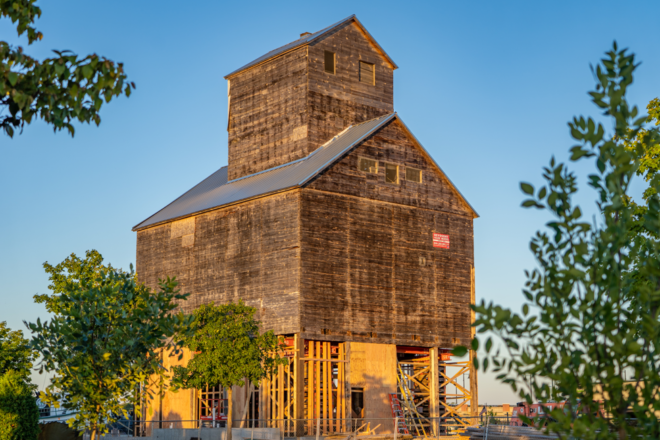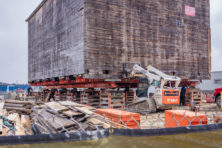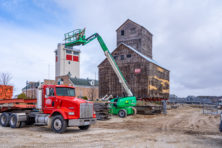Big Step for Door County Granary
- Share
- Tweet
- Pin
- Share

Structure lowered and reattached to base
The project to restore the Teweles and Brandeis grain elevator on the city’s West Waterfront reached a milestone Aug. 31 when DeVooght House Lifters & Building Movers lowered the building onto its 18-foot-tall column legs.
Door County Granary project manager Nicole Matson said the building’s upper two floors, which include the bin level and headhouse, were lowered eight or nine inches and reattached to the refurbished, original columns.
Laurel Hauser, president of the board of the Sturgeon Bay Historical Society Foundation, which is in charge of the Granary project, said that reattaching the upper two floors to the original columns was “perhaps the Granary’s most exciting week to date. This is the first time this has happened since the Granary was dismantled in 2018,” Hauser said.

Matson said the building had the appearance of being on stilts once it was lowered into place because the first floor was previously dismantled and is being rebuilt, with the construction of shear walls adding support to the structure.
“We’re really excited that we’re one whole building again,” she said.
The project’s architect, James Dallman, said lowering the building in place onto the columns faced a challenge of getting it to sit level. He said the building had been sitting on cribbing for four years, upon being dismantled in 2018, and it ended up not being completely level as a result.
He said there was no danger to the building itself to lower it onto the columns, but a decision had to be made about how to get it to sit level, such as whether to reduce the height of any of the columns.
“They decided to keep all the columns the same height and hope that the second layer of the cake would settle where it should – which it thankfully did,” Hauser said.
Dallman said it wasn’t necessary to cut the columns because the building’s wooden structure, compared to one constructed of metal, had some “give” to be able to get it to sit level.
“The wood’s a little more forgiving,” he said.
Dallman said Immel Construction’s installation of the shear walls, which is being overseen by Greenfire Management Services, should take two to three weeks to complete.
Once the shear walls are in place, he said some of the subsequent steps include installing steel siding obtained from a granary that was dismantled in Superior and putting windows in place, with the precise sequence for those steps still being worked out.
The project must be substantially completed by April 30, 2023, according to an agreement with the Sturgeon Bay Common Council. Dallman and Matson said they both believe that completion date can be met.
The project is being funded by private donations, and Matson said the Sturgeon Bay Historical Society Foundation continues to raise money for it.




